Always wanted to grow and eat your own fresh strawberries but don’t have the dedicated space to grow them in the ground? Then growing loads of fresh strawberries in pots and containers is the perfect solution!
When you grow in pots and containers, you can enjoy the flexibility of growing fresh fruit almost anywhere. A sunny spot on your front porch. A hanging basket on your back patio – or anywhere you have a little sun and enough room for a container can become the perfect location for growing strawberries.
Since strawberry plants don’t produce deep roots, the types of containers you can use are nearly endless. From tiered terracotta towers to hanging baskets and window boxes, you can have success getting strawberries to grow almost anywhere!
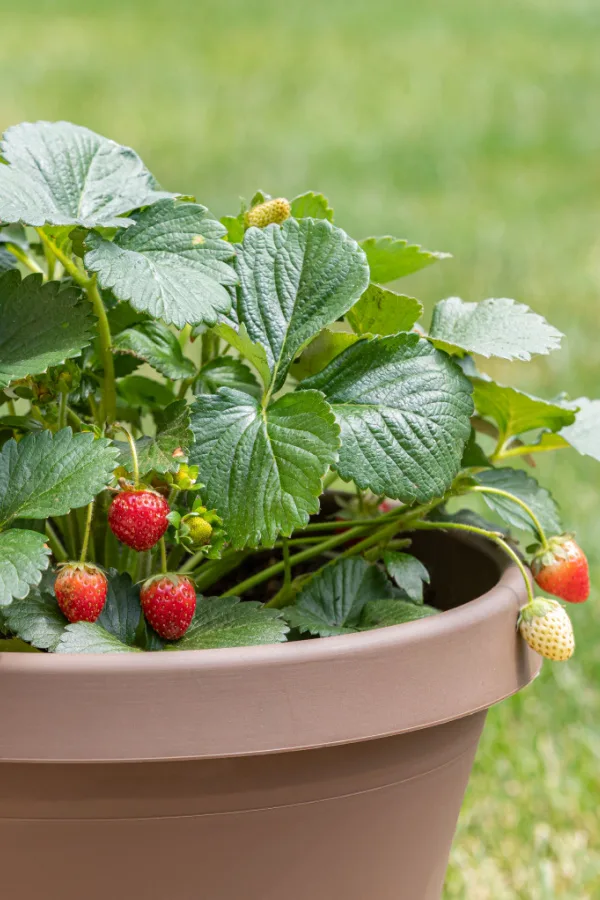
And there are other advantages too. Growing strawberries in pots means they are better protected from slugs and other garden pests. They also typically get better airflow, helping to prevent many bacterial issues and diseases you might get with in-ground strawberry patches.
However, there are still a few things to keep in mind in order to have healthy plants. And by simply following the basic tips below, you can have success producing a harvest that is just as bountiful as the one you would get from a garden or raised bed.
Types Of Strawberry Plants
Before we dive into how to grow strawberries in pots, we need to briefly talk about the different kinds of strawberry plants. There are two main types of strawberry plants: June-bearing plants and Everbearing plants.
As the name suggests, June-bearing plants only put on fruit once during the early summer. They are perfect if your goal is to pick and preserve a lot of large-sized fruit at the same time. Plants are typically thinner and produce a ton of runners (i.e., stems that turn into new “daughter” plants).
Everbearing plants, on the other hand, typically produce a decent amount of smaller fruit in late spring and again in early fall. You can also have a few stragglers here and there during the summer months as well. While everbearing strawberries still produce some runners, they are usually the better option for pots and container growing.
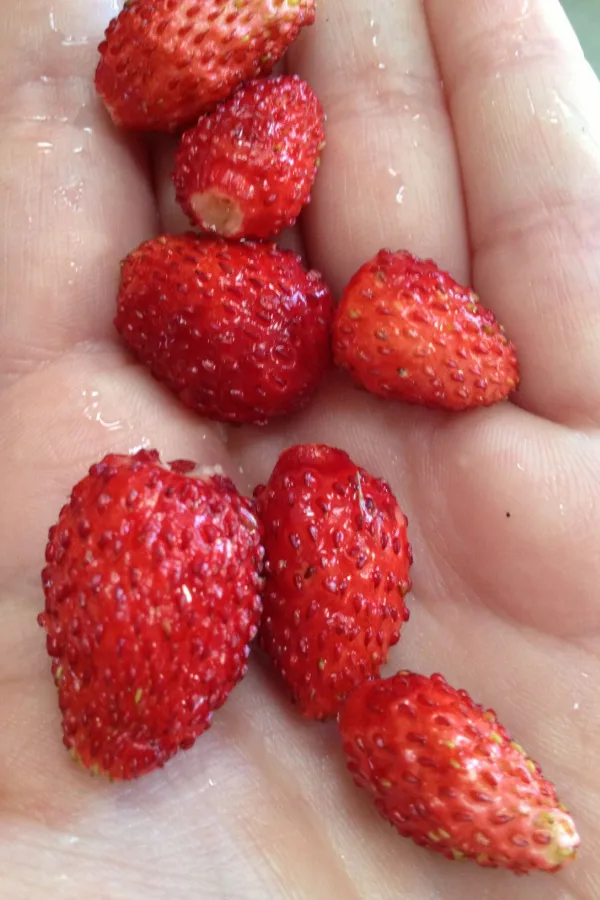
There are also varieties called Alpine strawberries. They produce fruit that is delicate and sweet, but they are very tiny and often not worth growing in containers. However, the plants themselves do not produce runners and stay small and compact, so it might still be an option to consider if you are wanting tiny fruit that packs a punch flavor-wise.
How To Grow Strawberries In Pots & Containers
Once you decide which variety of strawberries you are going to grow in your pot, it’s time to get growing! Plant strawberries in early spring when the threat of frost has passed.
The plants are available as either transplants or as bare-root crowns. Either work fine for container growing, but bare root crowns take a bit longer to become established and start to produce foliage.
Planting Strawberries In Pots
Choose a container that has adequate drainage and is at least six inches deep. While strawberry plants don’t produce deep roots, you still need to ensure that they have enough room to take hold. The drainage holes will allow any excess water to drain out of the pot.
Fill your container with a well-draingin potting soil mix that has been amended with plenty of compost. This mixture will help retain moisture while still allowing the excess water to drain off. The added compost helps give the plants a great boost of nutrients right from the start.
Aim for planting three plants per square foot of space. So, for example, if your pot is 12 inches by 12 inches, then you can grow about three plants in that space.
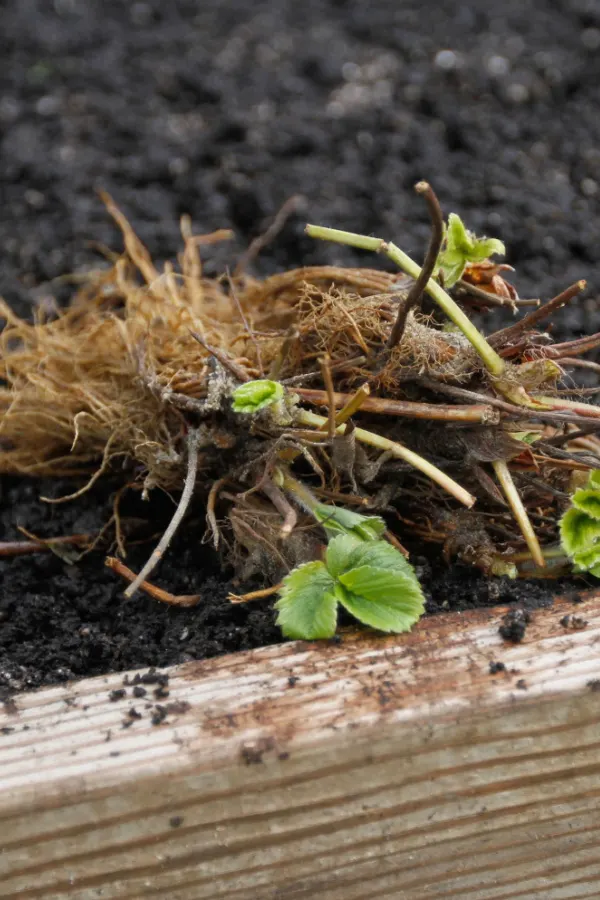
Next, create a hole, allowing plenty of space for the roots to be spread out. Plant the strawberries so that the crown is just above the soil line. If you bury the crown, it has a higher chance of rotting. You can also create a small mound when planting to raise the plant off the soil line slightly.
Backfill with more soil, being sure to lightly pack down as you go. Water plants well and add more soil if needed. Again, do not bury the crown.
Using Mulch
Even though the strawberry plants are growing in pots and containers, it’s still a good idea to use a little bit of mulch around the plants. A natural mulch like shredded straw or grass clippings will help to retain moisture, regulate the soil temperature, and also keep the fruit cleaner.
Just like you would use landscape fabric or another type of organic mulch for in-ground or raised bed planting, the mulch will help your potted strawberry plants as well.
Proper Location
Place your pot or container in a location that receives full sun (at least eight hours of sunlight a day). You also want to keep in mind other elements like wind and pests when choosing your location. Taller containers like plastic tiered planters will be more likely to tip over if placed in a spot that receives high winds. (Product link: 5-Tier Strawberry Planter)
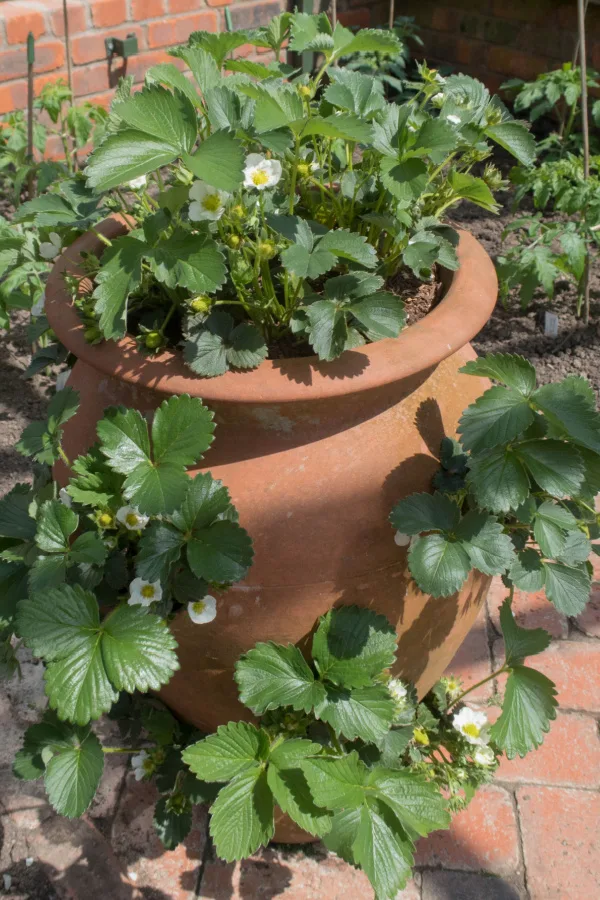
As for pests, you aren’t the only one who enjoys juicy ripe strawberries! Pests like birds, insects, and even rodents will all be drawn to those red berries. Consider using netting or even some kind of fencing to help deter these pests from beating you to the harvest.
Maintenance – Spring Through Fall
Now that your strawberries are in their pots, there are a few basic maintenance tips you need to perform in order to get them growing to their optimum potential.
Watering
Since strawberries that don’t grow in pots don’t have the luxury of surrounding soil to help retain moisture, you will need to water them more often. Their shallower roots also mean you can’t allow the soil to dry out much between watering.
Water plants after the top inch of the soil is dry. That means you likely need to water at least once a day, sometimes twice day during really hot spells. Allow the excess water to drain properly. Avoid watering overhead whenever possible so excess moisture doesn’t get on the foliage. Water early in the morning at the base of the plants.
Fertilizing
You don’t need to fertilize plants right away since you added compost at the time of planting. It is a good idea though to add a light dose of fertilizer about once a month. Using compost tea or worm-casting tea is another great (and all-natural) option.
Overwintering Strawberries Grown In Pots
Since strawberry plants are perennials, you have two options during the winter months. You can decide to treat the plants as annuals and replace them each year. Unfortunately, that option can get a bit expensive as the years go along.
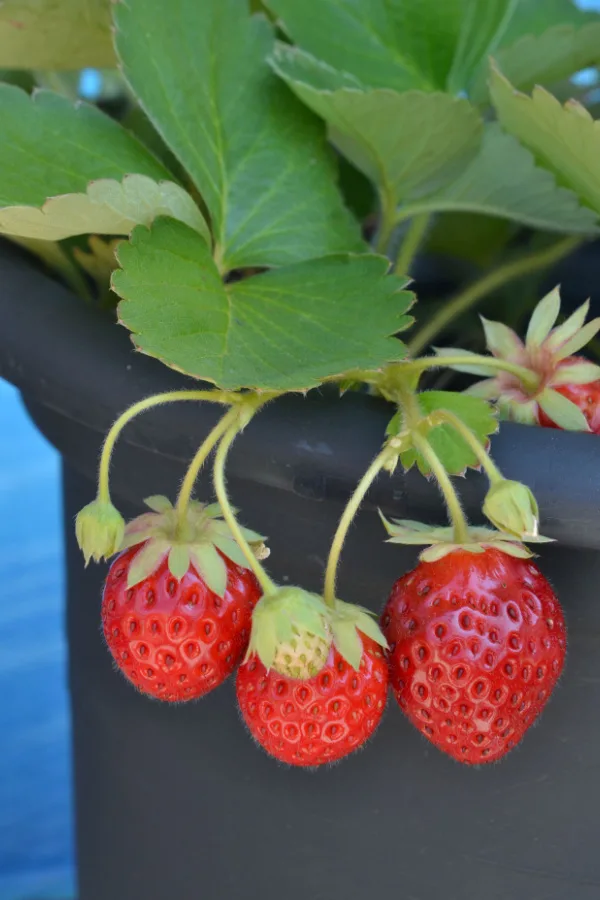
Another option is to bring the containers into a protected space during the colder months while the plants go dormant. After they are done producing, move the strawberry pots to an unheated garage, shed, or even under a covered porch or deck.
Only water when the soil is completely dry until freezing temps take hold, then withhold watering. Covering plants with mulch will also help to protect the cold hardy perennials.
Once spring rolls around again, set your strawberry pot back outside in a sunny location and remove any excess mulch. Give plants a good dose of fertilizer and follow the above tips for another great year of harvesting.
After about 4 to 5 years, you will likely need to replace plants altogether since they will start to slow down on production. But that still gives you plenty of time to enjoy those freshly picked, juicy strawberries all grown right from pots and containers!
Follow Our Facebook Page For Even More Great Tips! Simple Garden Life Facebook Page
Simple Garden Life is a website dedicated to keeping gardening fun, simple and enjoyable! We publish two new articles each week along with a new garden podcast episode every two weeks. This article may contain affiliate links.
